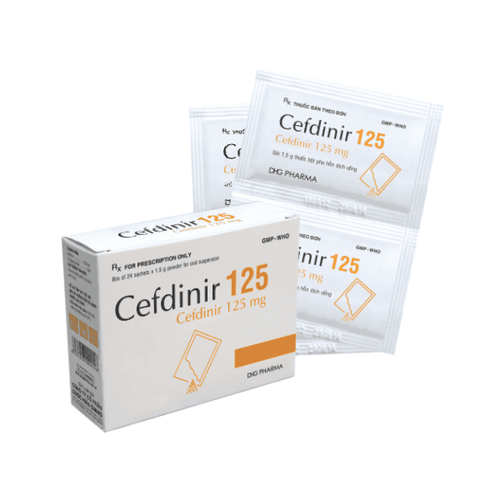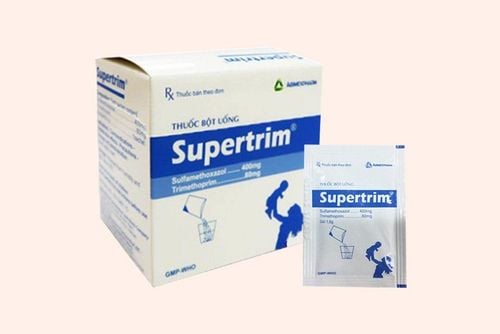This is an automatically translated article.
Ponaicef is made in the form of film-coated tablets, the main ingredient in each tablet is Ofloxacin and other excipients in sufficient concentration. So what is Ponaicef, how does it work and how to use it?
1. What is Ponaicef?
Ponaicef's main ingredient is Ofloxacin, a fluoroquinolone antibiotic similar to Ciprofloxacin, but Ofloxacin has a higher bioavailability (over 95%) when taken orally.
Ofloxacin has a broad antibacterial spectrum including: Enferobocteriacede, Haemophilus influenzae, Pseudomonas aeruginosa, Neisseria spp., Staphylococcus, Streptococcus pneumoniae, some other strains of Mycobacterium spp, Moraxella catarrhalis, N. meningitidis, Gardnerella vaginalis, Helicobacter pylori, Legionella spp. , Pasteurella multocida, Vibrio SDp, and several other Gram-positive bacteria.
Ofloxacin has stronger effect than Ciprofloxacin against bacteria Ureaplasma urealyticum, Chlamydia trachomatis, Mycoplasma pneumoniae. This active ingredient is also active against Mycobacterium leprae, Mycobacterium tuberculosis and other Mycobacterium spp.
Ofloxacin resistance has been reported in some bacterial strains such as Neisseria gonorrhoeae, Brucella melitensis, Acinetobacter spp., Campylobacter spp, Corynebacterium spp, E. c LS Klebsiella pneumoniae, C. jejuni, Ps. aeruginosa, N. gonorrhoeae, Str. pneumoniae. Most anaerobic bacteria, including Bacteroides fragilis and Clostridium difficile, are resistant to this antibiotic. However, some other strains of Clostridium spp may still be susceptible to Ofloxacin. Ofloxacin is an antibiotic with bactericidal effect, but the mechanism of action of the drug is still not fully known. Like the Quinolone antibiotics, Ofloxacin inhibits DNA - gyrase, an enzyme necessary for bacterial DNA replication, transcription, and repair.
2. Indications and contraindications of Ponaicef
Ponaicef is indicated in the treatment of infections caused by susceptible bacteria such as:
Severe bacterial bronchitis; Pneumonia ; Chlamydia infection of the cervix or urethra with or without gonorrhea; Uncomplicated gonorrhea; Prostatitis; Urinary tract infections; Skin and soft tissue infections; Inflammation of the colon due to bacterial infection. Ponaicef is contraindicated in the following cases:
People with a history of hypersensitivity to Ofloxacin or other antibiotics of the Quinolone group or to other ingredients in the preparation; Do not use for children under 15 years old; Pregnant women; Breastfeeding women Use Ponaicef with caution in the following cases:
Patients with epilepsy or a history of central nervous system disorders; The dose of Ponaicef must be reduced in patients with renal failure; Avoid exposure to direct sunlight or ultraviolet rays during treatment with Ponaicef; Fluoroquinolone antibiotics, including Ofloxacin (the main ingredient of Ponaicef) are associated with an increased risk of inflammation and tendon rupture at all ages, especially the Achilles tendon. Therefore, Ponaicef should be discontinued if the patient experiences swelling, pain, inflammation or rupture of the ligament. Ofloxacin in Ponaicef increases the risk of joint diseases, especially cartilage degeneration. Therefore, Ponaicef should not be used in children, pregnant and lactating women. Treatment of infections with Ponaicef alters the normal microflora of the intestine leading to overgrowth of clostridium difficile, leading to diarrhea, which in more serious cases can lead to pseudomembranous colitis which can be fatal.
3. Dosage and how to use Ponaicef
Ponaicef is used orally. Dosage of Ponaicef should be according to the doctor's prescription, the reference dose for adults in the following specific cases:
Severe bacterial bronchitis, pneumonia: Use a dose of 400mg/time every 12 hours 1 time, for 10 days. Chlamydia infection (in the cervix or urethra): Use a dose of 300mg / time every 12 hours / 1 time, for 7 days. Uncomplicated gonorrhea: Use a dose of 400mg/time, a single dose. Prostatitis: Use a dose of 300mg / time every 12 hours / time, for 6 weeks. Skin and soft tissue infections: Use 400mg every 12 hours for 10 days. Urinary tract infections: E. coli or K, pneumoniae cystitis: Use a dose of 200mg every 12 hours, for 3 days. Cystitis caused by other bacteria: Use a dose of 200mg every 12 hours, for 7 days. Complicated urinary tract infections: Use 400mg every 12 hours for 10 days. Adults with impaired renal function: Creatinine clearance > 50ml/min: Use the same dose as normal people, every 12 hours. Creatinine clearance from 10 - 50 ml/min: Use unchanged dose, every 24 hours. Creatinine clearance <10 ml/min: Use half dose, every 24 hours. Little is known about Ofloxacin overdose. Symptoms of drug overdose can be CNS toxicity, heart, bone and joint damage and liver as well as kidney failure. Current recommendations for the management of acute Ponaicef overdose are gastric emptying, adequate rehydration, use of supportive measures, and close monitoring. Renal dialysis or peritoneal dialysis are less effective in this case.
4. Side effects of the drug Doncef
During the use of Ponaicef, you may encounter some side effects of the drug, including:
Nausea, vomiting; Diarrhea ; Stomachache; Digestive disorders; Headache ; Dizzy; Tired; Run; Insomnia ; Nightmare; Visual disturbances; Rash; Itchy; Hypersensitivity-type skin reactions. If you see any unusual symptoms of Ponaicef, you should immediately notify your doctor or go to a medical facility for timely medical assistance.
5. Interactions with other drugs
Concomitant administration of Ponaicef with non-steroidal anti-inflammatory drugs, does not increase the effect of psychosis, so special caution is not required when using Quinolone antibiotics with non-steroidal anti-inflammatory drugs. The absorption of ofloxacin in Ponaicef is not altered by Amoxicillin. Serum ofloxacin levels may be reduced below therapeutic levels when Ponaicef is used concomitantly with aluminum and magnesium-containing antacids. The article has provided information about the uses, doses and precautions when using Ponaicef. To ensure safety for your health and maximize the effectiveness of your treatment, you need to take Ponaicef exactly as directed by your doctor.
Please dial HOTLINE for more information or register for an appointment HERE. Download MyVinmec app to make appointments faster and to manage your bookings easily.













